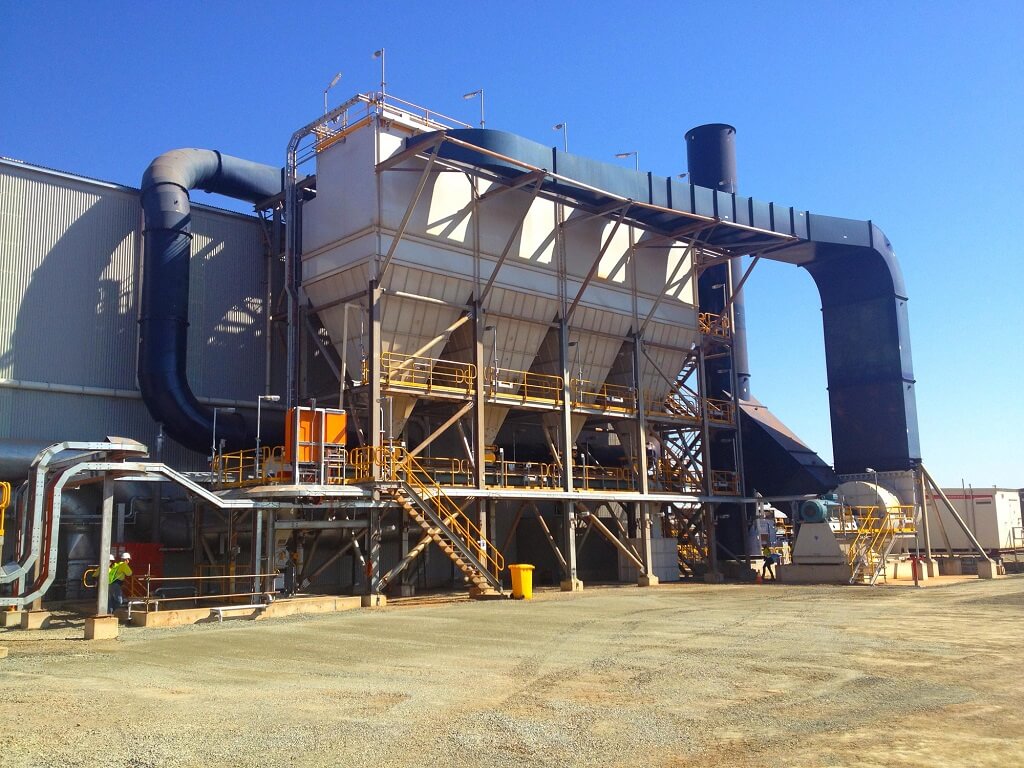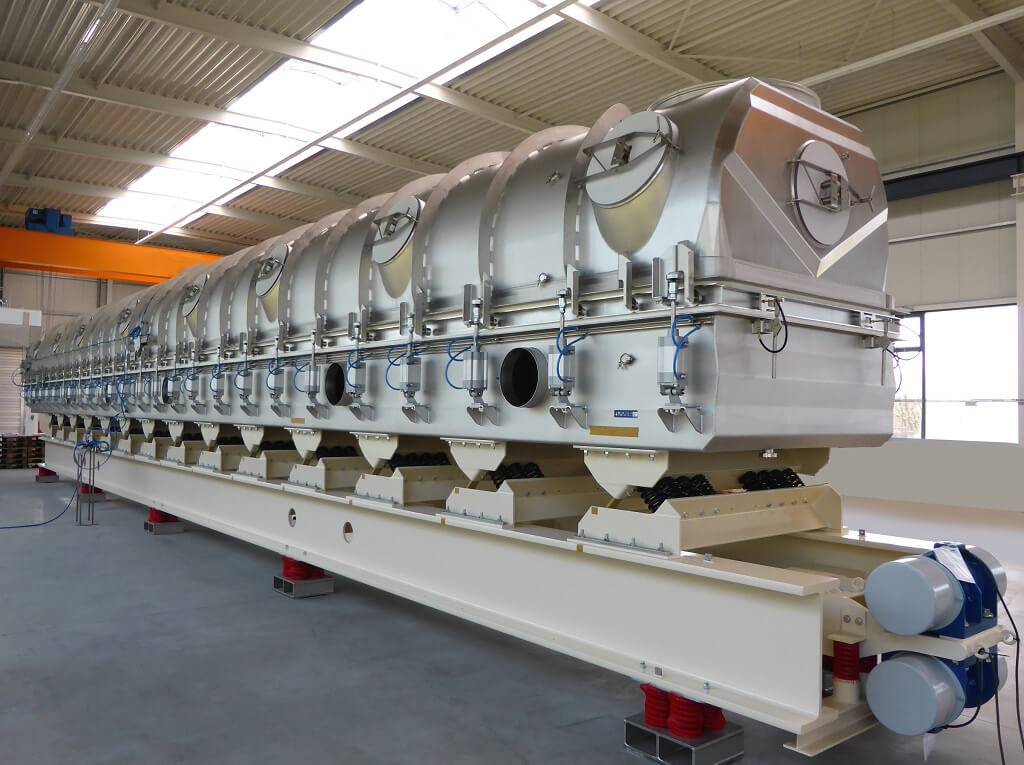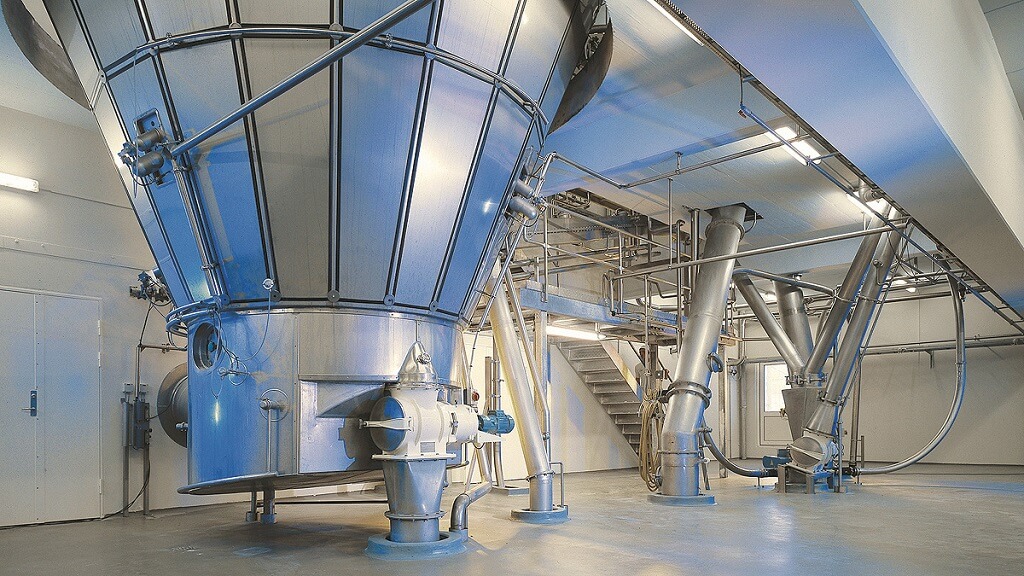In the drying system, dust with small particle sizes is sometimes produced, and the finished product cannot be completely collected only by the cyclone separator, which requires the addition of a second-stage dust collection system. At present, the commonly used industrial dust collectors are baghouse filters and wet scrubbers.
Baghouse Filter
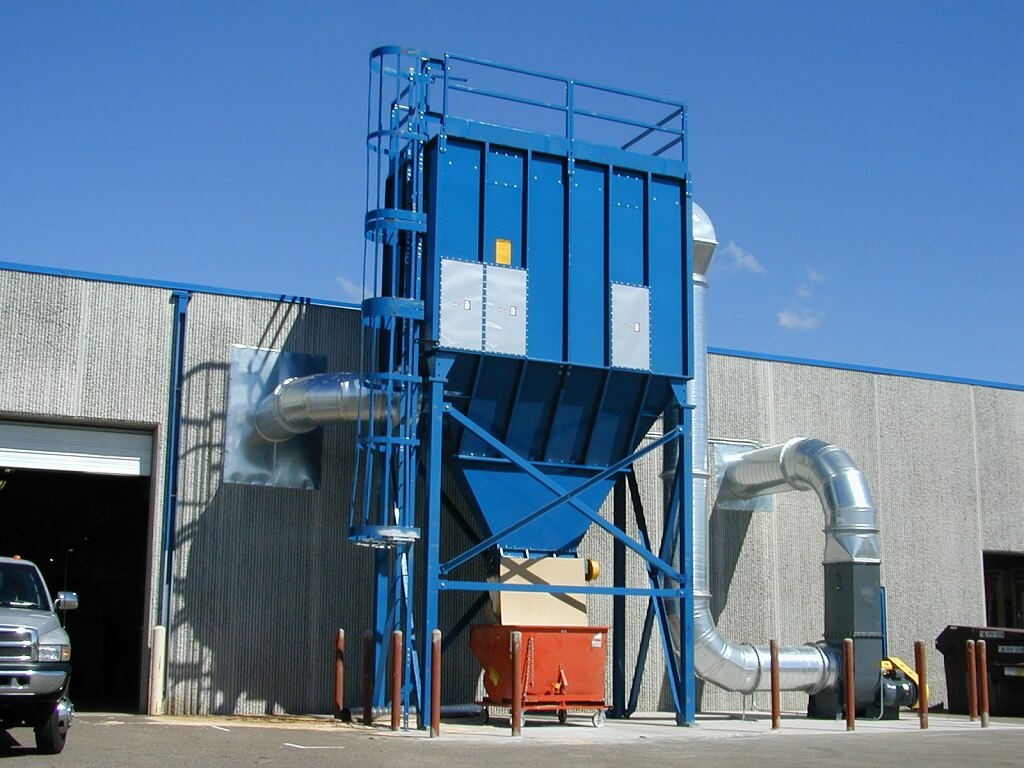
1. Introduction
The baghouse filter is a kind of dust collection system that uses porous fiber filter cloth to filter the dust in the dusty gas. Because the filter cloth is made into a bag shape, it is generally called a baghouse filter.
It has been widely used in the collection of non-bonding and non-fibrous dust in many industrial production and environmental protection processes. In terms of quantity, the application of baghouse filters accounts for more than 60% of the total amount of dust collectors.
2. Advantages of Baghouse Filter
- High dust collection efficiency, for 5μm particles, the dust collection efficiency can reach more than 99%.
- Stable operation, strong adaptability, processing gas volume from hundreds to hundreds of thousands of cubic meters per hour.
- Simple structure and low technical requirements.
- Low investment costs.
- Reliable operation.
3. Disadvantages of Baghouse Filter
- Consumes more fabric.
- Can only be exposed to lower temperature gases.
- If the gas contains high moisture content or dust with strong water absorption, it will cause the filter cloth to be blocked.
4. Working Principle
The working principle of the baghouse filter is that the dust is captured by the effects of screening, inertia, adhesion, diffusion and static electricity when passing through the filter cloth.
Screening function: When the dusty gas passes through the filter cloth, the gap between the fibers of the filter cloth separates the dust that is larger than the gap. For a new filter cloth, the dust removal efficiency will be lower due to the large gaps between the fibers. Only after using it for a period of time, a certain thickness of dust layer is formed on the surface of the filter cloth, and the screening effect will be more significant.
Inertial effect: When the dusty gas passes through the filter cloth fiber, due to the inertial effect, the dust still keeps moving in a straight line and hits the fiber to be collected. The larger the dust particle, the greater the inertial effect. In addition, the higher the filtration wind speed, the greater the inertial effect, but if the filtration wind speed is too high, the air volume passing through the filter cloth will also increase, and the filtration wind will penetrate through the weak point of the filter cloth, resulting in a decrease in dust removal efficiency.
For filter cloths made of different materials, the influence of filtration air speed on dust collection efficiency is different, see the table below for details.
Pressure Loss | 0~300Pa | 300~1200Pa | |||||
Filtration Wind Speed (m/min) | 0.5 | 1.0 | 1.5 | 0.5 | 1.0 | 1.5 | |
Dust Removal Efficiency (%) | Twill Glass Cloth | 98.5% | 77.0% | 67.0% | 99.8% | 93.3% | 85.4% |
Thin Satin Glass Cloth | 89.5% | 71.0% | 57.5% | 95.0% | 80.3% | 68.7% | |
Thick Satin Glass Cloth | 98.0% | 75.0% | 65.0% | 99.8% | 90.0% | 82.0% | |
Plain Silk | 98.7% | 76.0% | 66.0% | 99.8% | 90.5% | 84.0% | |
Single Face Cotton | 99.9% | 99.8% | 99.8% | 99.9% | 99.9% | 99.8% | |
Woolen | 99.9% | 99.8% | 99.8% | 99.9% | 99.8% | 99.2% | |
Diffusion effect: When the dust particles are below 0.2μm, the Brownian motion of gas molecules is generated due to the extremely fine dust, which increases the chance of contact between the dust and the surface of the filter cloth, so that the dust is collected. This diffusion effect is opposite to the inertial effect, which increases with the decrease of the filtration wind speed and increases with the decrease of the dust particle size.
Adhesion effect: When the dusty gas approaches the filter cloth, the fine dust still moves with the airflow. If the radius of the dust is greater than the distance from the center of the dust to the edge of the filter cloth, the dust is adhered by the filter cloth and collected. The smaller the gap of the filter cloth, the stronger the adhesion.
Electrostatic effect: Dust particles collide with each other and emit electrons to generate static electricity. If the filter cloth is an insulator, it will charge the filter cloth. When the charges of the dust and the filter cloth are opposite, the dust will be adsorbed on the filter cloth, thereby improving the dust removal efficiency. Conversely, if the charges of the two are the same, a repulsive force will be generated, which will reduce the dust removal efficiency. Generally, the electrostatic effect is only effective when the particle size of the dust is less than 1 μm and the filtration wind speed is very low.
5. Filter Cloth Material
The selection of filter cloth material needs to consider the properties of dust-containing gas, dust concentration, dust particle size, chemical properties, moisture content, and gas temperature.
The requirements for filter cloth are uniform and dense material, good air permeability, heat resistance, wear resistance, corrosion resistance, and water repellency.
The properties of common filter cloth materials are shown in the table below.
Filter Cloth Material | Density(kg/dm3) | Tensile Strength (MPa) | Acid Resistance | Alkali Resistance | Heat Resistance (℃) | Moisture Absorption Rate (%) | Filtration Wind Speed (m/min) | |
Natural Fiber | Cotton | 1.5~1.6 | 345 | Poor | Good | 70~80 | 8~9 | 0.6~1.5 |
Wool | 1.28~1.33 | 110 | Good | Poor | 80~90 | 10~15 | ||
Synthetic Fiber | Nylon | 1.14 | 300~600 | Moderate | Good | 75~85 | 4~4.5 | 0.5~1.3 |
Oron | 1.15 | 200~900 | Good | Moderate | 125~135 | 1.3~20 | ||
Polyester | 1.38 | 300~700 | Good | Good | 140~160 | 0.4 | ||
Inorganic Fiber | Glass Fiber | 2.4~2.7 | 1000~3000 | Good | Good | 200~260 | 0 | 0.3~0.9 |
Wet Scrubbers
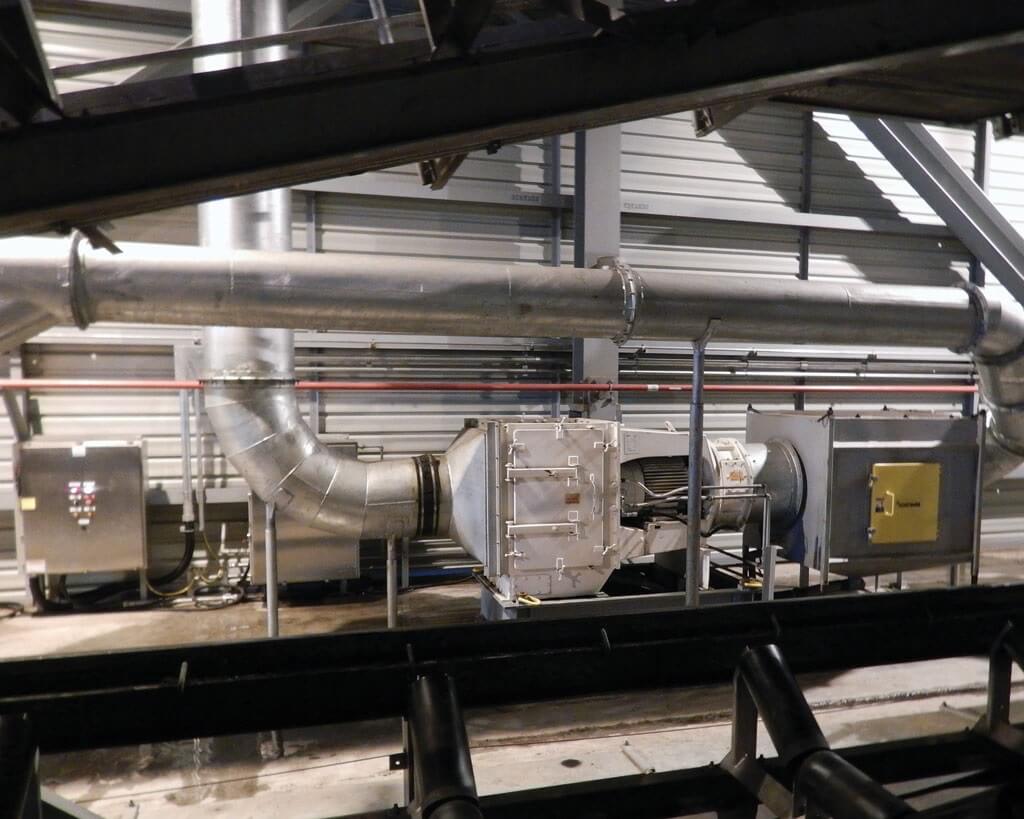
1. Introduction
Wet scrubbers are also commonly referred to as wet scrubbers. This equipment that makes dusty gas contact with water or other liquids and uses the inertial collision of water droplets and dust particles to separate the dust particles from the airflow is called a wet scrubber.
It uses a liquid as a medium, so it is suitable for non-fibrous, dust-laden gases that can be cooled and do not chemically react with water.
In the drying system, the wet scrubber is often used as the second-stage dust removal device, especially when it is difficult to apply the baghouse filters, the wet dust removal method should be considered.
2. Advantages of Wet Scrubbers
- Less investment.
- Simple structure.
- Easy to operate and maintain.
- Small footprint.
- Purify harmful gases.
- Flue gas cooling and humidification.
- It is suitable for handling high temperatures, high humidity, and explosive gas.
3. Disadvantages of Wet Scrubbers
- The sewage and sludge generated in use need to be treated, otherwise, it will cause water pollution.
- When the gas contains corrosive media, anti-corrosion measures should be considered.
4. Working Principle
The gas containing suspended dust particles is in contact with the liquid. The dust particles adhere to the wall after the gas contact with the wall, or when the gas collides with the sprayed liquid droplets, the liquid condenses on the dust particles, making them land.
In the wet scrubber, there are two ways of contacting gas and liquid, one is the contact between gas and atomized water droplets, such as Venturi scrubber, water film type scrubber, and spray scrubber; the other is the gas impacts the water layer, it bubbles to form fine water droplets.
Inertial impact: The inertial collision between particles and water droplets is the most basic dust removal function. For dust particles with a size above 0.3 μm, the collision efficiency between dust particles and water droplets depends on the inertia of dust particles. Increasing the relative velocity of the airflow and droplets, and reducing the droplet diameter are the two main ways to improve dust removal efficiency.
Diffusion: for dust particles with a particle size below 0.3 μm. Diffusion is an important collection factor. Under the impact of gas molecules, particles, like gas molecules, perform complex Brownian motion. During the movement, dust particles and water droplets are collected due to contact.
Adhesion: Similar to the adhesion effect of the baghouse principle, that is, when the radius of the dust particle size is greater than the distance from the dust center to the edge of the water drop, the dust is adhered by the water drop and collected.
Diffusion drift: If the saturated vapor comes into contact with the surface of the cold liquid, the saturated vapor will condense on the surface of the cold droplet, and a force will be generated to push the tiny dust particles to move toward the droplet and settle on the droplet. If a droplet evaporates, the tiny dust particles are repelled by the droplet. The movement of dust particles toward the droplets is called positive diffusion drift, and the movement of dust particles away from the droplets is called negative diffusion drift.
5. Types of Wet Scrubbers
Name | Air Volume (m3/h) | Resistance (Pa) | Efficiency (%) | Water Consumption (kg/h) |
Spray Dust Collector | 2000~50000 | 400~700 | >70 | 2000~10000 |
Water Bath Dust Collector | 1000~24000 | 500~760 | >50 | 100~6000 |
Water Film Dust Collector | 1600~13200 | 250~550 | >80 | 540~1620 |
Foam Dust Collector | 100~1400 | 259~1250 | >90 | 250~3000 |
Horizontal Cyclone Water Film Dust Collector | 13200~33000 | 750~1250 | >92 | 120~700 |
Granite Water Film Dust Collector | 10500~312000 | 1000~1500 | 95 | 3500~47000 |
Impulse Dust Collector | 4500~75200 | 1100~1600 | >85 | 500~5100 |
Venturi Dust Collector | 3000~70000 | 1000~12000 | >95 | 300~1000 |
6. Factors to Consider when Choosing Wet Scrubbers
Dust removal efficiency: The efficiency of the wet scrubber is the most important indicator. The gas flow rate under a certain state, specific dust pollutants, and the state of the gas has a direct impact on the collection efficiency.
- Operational flexibility: For any operating equipment, its load must be taken into account, and how the collection efficiency will be affected when the gas flow exceeds or falls below the design value. Similarly, it is also necessary to know how to operate when the dust concentration is unstable or continuously higher than the design value.
- Hydrophobic: The wet scrubber is not efficient in purifying hydrophobic dust.
- Cohesiveness: Wet scrubber can purify cohesive dust, but flushing and cleaning should be considered to prevent clogging.
- Corrosiveness: Anti-corrosion measures should be considered when purifying corrosive gases.
- Water consumption: how much water is consumed by the dust collectors and the discharged sewage treatment, as well as winter antifreeze measures for water.
- Slurry treatment: Slurry treatment is an inevitable problem for wet scrubbers, and efforts should be made to reduce the degree of pollution hazards.
- Maintenance: Generally, rotating parts should be avoided inside the dust collectors, and attention should be paid to blockage caused by a small amount of gas passing through the flow channel section.

